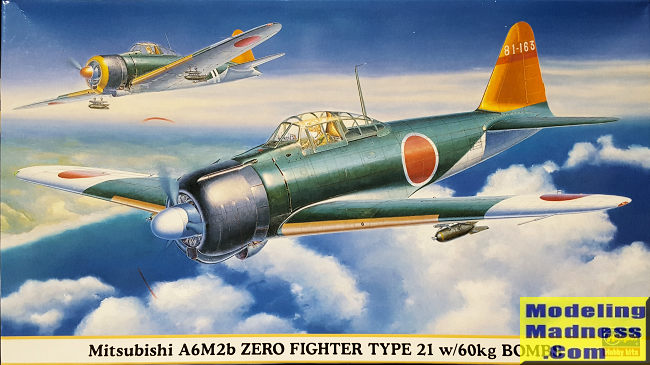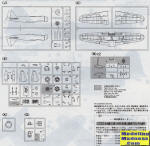
|
KIT # |
09626 |
|
PRICE: |
2400 yen |
|
DECALS: |
Two options |
|
REVIEWER: |
Scott Van Aken |
|
NOTES: |
2005 boxing |

|
HISTORY |
|
THE KIT |
 Hasegawa pretty well has the field for 1/48 Zeros,
though Tamiya is making inroads. They
box almost every known variant, including some rather rare types, like
the A6M8. All use the same basic fuselage, cockpit and tail section as
that was unchanged. They simply change the wings and the engine to match
whatever version is being done.
Hasegawa pretty well has the field for 1/48 Zeros,
though Tamiya is making inroads. They
box almost every known variant, including some rather rare types, like
the A6M8. All use the same basic fuselage, cockpit and tail section as
that was unchanged. They simply change the wings and the engine to match
whatever version is being done.
This results in several inserts and add on bits that vary from one aircraft type to another. It also means that the main molds do a lot of service. My kit was boxed in 2005 and is in superb shape, which tells me that perhaps they cut another set of molds or have at least taken good care of what they have. As one expects from Hasegawa, the level of detail is quite good. There are lots of aftermarket bits for the Zero should you wish that additional level of detail, but most of us will be quite satisfied with what comes in the box. I especially like that there are instrument decals provided that fit perfectly over the various panels. Saves my having to paint these things and looks a ton better than I could ever do myself.
Options for the kit are quite limited. You basically have the choice of leaving the canopy open or closed. This kit has a pair of 60kg bombs and racks. To get these items, a sprue section from the A6M2-N Rufe kit is included. One does have to open the holes for these in the lower wings prior to completing the wings.
 Instructions
are excellent and give all colors in Gunze references. There are options for
two aircraft. One is the box art plane with the orange fin from the 381st
Naval Flying Group in the Philippines during 1944. The orange fin is
provided as a decal, but you may wish to paint it instead. The front half of
the spinner is white, as are the outer upper wings. As much as I'd liked to
have the second plane on the box art as an option, it is not included.
Instead a plane from the Shokaku fighter group in 1942 is included. Decals
are old school so the whites are off-white. Note that you get a bunch of
extra fin numbers for the first option if you wish to substitute any.
Instructions
are excellent and give all colors in Gunze references. There are options for
two aircraft. One is the box art plane with the orange fin from the 381st
Naval Flying Group in the Philippines during 1944. The orange fin is
provided as a decal, but you may wish to paint it instead. The front half of
the spinner is white, as are the outer upper wings. As much as I'd liked to
have the second plane on the box art as an option, it is not included.
Instead a plane from the Shokaku fighter group in 1942 is included. Decals
are old school so the whites are off-white. Note that you get a bunch of
extra fin numbers for the first option if you wish to substitute any.
|
CONCLUSIONS |
Overall, it is an excellent model. I know that the Eduard kit is the current darling of modelers, but one shouldn't overlook the Hasegawa offerings. They can be picked up for a decent price nowadays and are well worth building.
May 2023
Copyright ModelingMadness.com. All rights reserved. No reproduction in part or in whole without express permission from the editor.
If you would like your product reviewed fairly and fairly quickly, please contact the editor or see other details in the Note to Contributors.